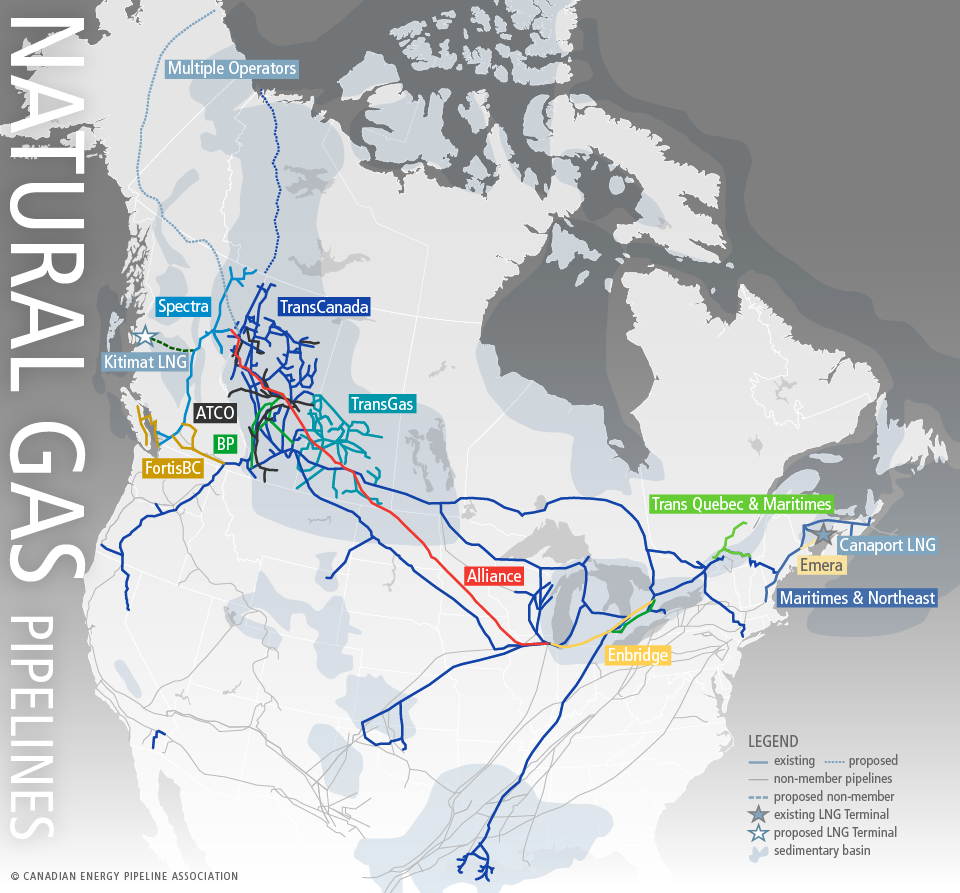July 2015, Vol. 242, No. 7
Features
Fate of Canadas Export Pipelines Dependent on LNG Permits

With reserves of 1,093 Tcf, Canada is the world’s fifth-largest producer of dry natural gas, ranking behind the United States, Russia, Iran and Qatar.
About two-thirds of Canada’s 156 Bcm of gas output comes from the Western Canadian Sedimentary Basin (WCSB) that straddles the eastern slopes of the Rocky Mountains in British Columbia and the plains of the Yukon, southwestern Manitoba, southern Saskatchewan and Alberta.
In addition, some gas is extracted offshore in the Atlantic waters of Nova Scotia. According to International Energy Agency (IEA) figures, although Canada’s natural gas production is slowly declining from 181Bcm in 2000 to 156 Bcm in 2012, domestic demand of 55% of production leaves a surplus of 56 Bcm for export.
Canada has extensive shale reserves in the Duvernay formation of Alberta and the Montney formation that runs from the deep north of Alberta into British Colombia, which could potentially offset declines in conventional gas production and increase gas output in coming years.
For decades Canadian gas producers have relied almost exclusively on a single-export market, the United States. Currently, natural gas is transported from the WCSB through an extensive transmission and distribution pipeline distribution network to both domestic and industrial consumers throughout Canada and the United States.
Today, Canada’s gas pipeline network stretches across the country, from gas fields in the WCSB, serving Canadian cities such as Vancouver in the west and Toronto and Quebec in the east. In addition, through 22 cross-border pipelines at 10 major export points, the network connects into the regional pipeline networks of the United States, thus allowing Canadian gas to reach Los Angeles, St. Louis and New York.
Pipeline deliveries from Canada account for nearly 98% of all U.S. natural gas imports, but as the U.S. shale revolution has increased gas production by 35% between 2005-13, demand for Canadian gas has fallen by 26% between 2007-13. The stunning increase in American shale gas output and the consequent fall in U.S. natural gas prices also changed what was predominantly a one-way flow south from Ontario into a two-way flow. It is now cheaper to import gas from the United States into southern Ontario than to ship gas from western Canada to northern Ontario.
Canada’s 510,000 km of gas-gathering, transmission and distribution pipeline network is predominantly owned and operated by publicly traded companies of which three are significant for exports to the United States.
TransCanada operates a 25,100-mile network at a total average volume of 14 Bcf/d made up of the Natural Gas Transmission System (NGTL) System, the Canadian Mainline, the Foothills, and the Trans Quebec and Maritimes that connect supply in western Canada to the United States.
Spectra Energy operates a 1,800-mile, 2.9 Bcf/d pipeline system that connects western Canadian gas supply regions with markets in the United States and Canada. The company also operates the Maritimes & Northeast Pipeline, linking eastern Canadian supplies with consumers in the eastern United States.
Enbridge and Veresen operate the Alliance Pipeline, a 2,311-mile system delivering 1.6 Bcf/d from the WCSB to Chicago, which is a significant source of natural gas and natural gas liquids for the Midwest (Figure 1).
Concerning Trade
Pipeline shipments still dominate the declining Canadian gas exports to the United States. In November, shipments to the United States were just 227.4 Bcf, down 22% from the same month of 2008, according to EIA data.
This secular decline reflects a fundamental change in the supply and trade pattern of North America’s natural gas market owing to the arrival of huge quantities of natural gas from the Marcellus and Utica shale gas formations, combined with increased “take-away” capacity from recently constructed pipelines.
The Rockies Express, Bison and Ruby pipelines have given U.S. shale production areas direct access to traditional markets served by Canadian gas pipelines, such as America’s Northwest, Midwest and Eastern Canada markets. In particular, cheaper American gas from shale fields such as Marcellus, Utica, and Bakken are partially displacing Canadian gas pipeline deliveries to such markets as the Chicago region, New England and eastern Canadian provinces such as Ontario and Québec.
A case in point is the effect of Marcellus gas on the state of New York. From 2010-14, Marcellus gas output tripled to 9 Bcf/d and New York became a net exporter of natural gas to Canada. In the near future Marcellus gas could reach the major north-south pipeline network feeding the Gulf Coast, leaving Canadian producers competing for pipeline access.
Export Pipelines to LNG Plants
Faced with the prospect of a terminal decline in U.S. demand, Canada is reviewing proposals for 17 combined pipeline, ports and LNG export terminals to export LNG to Europe and Asia (Figure).
As is common in other countries, proposals for pipelines and LNG plants are subject to extended delays caused by environmental concerns, public opposition and low gas prices. Moreover, new sources of supply from Equatorial Guinea, Australia, Indonesia, and Russia and from the U.S.’s Sabine Pass Terminal in Louisiana as early as December will depress global LNG prices and further weaken the viability of some Canadian LNG export projects.
Conclusion
The prospects for new Canadian pipeline construction depend primarily on the success of applications for LNG export terminals. Construction of LNG export terminals, in turn, will depend on the availability and price of capital, willing buyers of Canadian LNG and access to shipping. With 90% of LNG tankers on a fixed long-term charter, it will be difficult for new entrants to gain access.






Comments